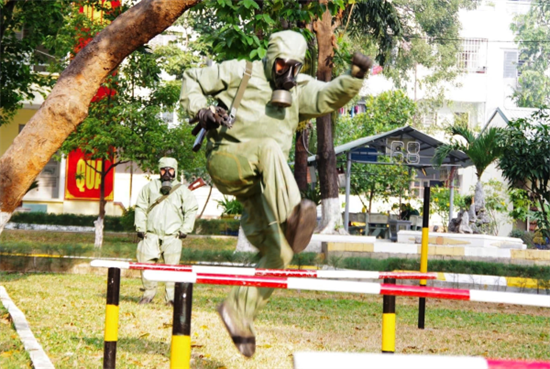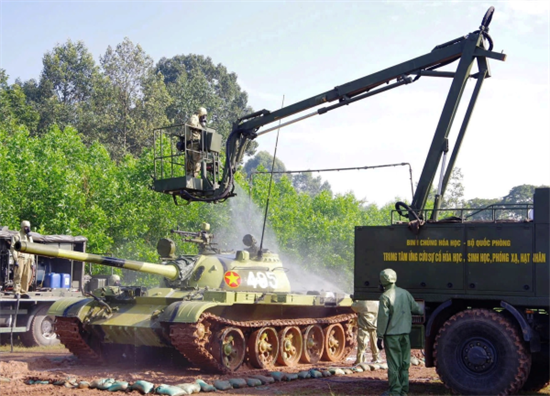As a strategic-level unit under the Chemical Corps Command, Chemical Brigade 87 is tasked with training, combat readiness, chemical support in the event of war, and terrorism and riot prevention and control. It is also assigned to respond to toxic chemical, radiological, nuclear, and environmental incidents, settle toxic remnants after wars, and maintain readiness for contingency missions. While its task requirements are increasingly demanding, the Brigade’s affiliates have to operate in a scattered, independent way; they are also confronted with dangers, poisonous environments, and safety risks; their technical equipment and means are diverse and complex; families of troops are still facing difficulties in their daily life. Against that backdrop, in addition to building politically, ideologically, organisationally strong offices and units, the Brigade’s Party Committee and Command have focused their leadership and direction on raising the quality of combat training, considering this as a central political task, a breakthrough measure, and a prerequisite for successfully fulfilling all missions.
 |
| Physical training for the Brigade’s cadres and soldiers |
Following its higher echelons’ resolutions, directives, and guidance on combat training work, the Brigade Party Committee has issued its own specialised resolution to strengthen all-level party committees and commands’ leadership and direction over training tasks, together with specific goals, targets, measures, and a focus on 4 main points, namely “awareness of training work; mechanisms for direction, management, and operation; content and methods of training; and support work”. The Brigade has required its offices and units to develop their own resolutions and action plans, introduce training tasks to all cadres and soldiers, and carry out propagation and education to render their troops fully aware of the role of training work as well as advantages and difficulties in performing this work. Offices and units of the Brigade have enhanced emulation movements, promoting mass organisations’ role in training tasks, heightening a sense of responsibility and discipline among cadres and soldiers in the training process. Besides, the Brigade has renewed forms and methods of examination and re-examination to make correct evaluations and point out weaknesses and the accountability of collectives and individuals in the process. It has also taken the outcomes of training as a criterion for personnel assessment, planning, appointment, and deployment. As a result, all cadres and soldiers of the Brigade have shown a strong sense of responsibility and great resolve for training work; the quality of this work has been unceasingly improved.
As the Brigade is tasked with combat support and provided with many different forces and types of specialised means and military hardware, its training content and requirements are very diverse. Hence, it has always focused on making elaborate preparations for training work, ranging from development of training plans and programs, refresher courses for cadres, design and approval of lesson plans to training facilities. Prior to each training season, it has carried out reviews and adjustments in terms of personnel and weaponry, with priority given to units tasked with training new soldiers, A2 mission, counterterrorism, natural disaster prevention and control, and search and rescue. At the same time, it has seriously maintained refresher courses for its cadres at all levels. Those refresher courses have been renewed to be relevant to the particularities and tasks of each group of cadres, each office, and each unit; while inferiors have been required to train their subordinates, offices have been asked to train units; emphasis has been placed on settling remaining issues and drawbacks, clarifying new, central issues, and improving cadres’ methods and hands-on skills in training work. Thanks to those approaches, the quality of cadres in charge of training work across the Brigade has been considerably raised. Moreover, the Brigade has carefully prepared weapons, means, materials, and training grounds for each speciality. Notably, it has proactively collaborated with localities and friendly units (tank and artillery) to employ vehicles and equipment for its troops’ practice, thereby enabling its troops to effectively deal with chemical, biological, and radiological terrorism scenarios.
 |
| Decontamination process for a tank during DT-24 exercise |
In the training process, the Brigade has directed its affiliates to closely follow the motto of “basics, practicality, solidity”, organise comprehensive but focalised and specialised training courses, take specialised chemical training as the centre, and regard training courses on responding to chemical, biological, radiological, and nuclear incidents in peacetime and ensuring chemical support in wartime as the foundation. Importance has been attached to training troops to master the existing and new technical equipment in forms of warfare using weapons of mass destruction. As for commands and offices, great value has been attached to improving their operational staff work and methods of holding and directing exercises on maps and in the field, making them capable of giving sound advice on operations and training, and enabling them to grasp regulations on commanding, managing, and training their affiliated units. Concerning detachment-level cadres, the Brigade has concentrated on bettering their command capability, working style, and methods of designing, approving, and rehearsing lesson plans. Regarding professional service men/women and technical staff, the Brigade has improved their comprehensive and specialised knowledge according to their positions and trained them to master the existing, new, modern technical equipment. Right after new recruit training courses, the Brigade has proactively organised specialised training courses, ensuring that new soldiers would quickly adapt themselves to specialised training formations. In the process, the Brigade has concentrated on classifying soldiers by group, promoting the role of model groups, integrating modern training into traditional training, aligning basic training with advanced training, enabling troops to master individual movements as the basis for detachment-level joint training, conducting training rotations scientifically to make use of time, materials, and training grounds. It has increased training and exercises using simulation methods and real-time automated command systems, while practising projects to respond to non-traditional security challenges and chemical, biological, radiological, nuclear, and environmental incidents.
To produce high effectiveness, the Brigade has renewed training management and operation work and adhered to training processes, from easy to difficult levels, from simple to complex levels, and from individual to detachment levels. While aligning direction with organisation, it has required all-level cadres to further monitor and inspect training work, stay close to training grounds, and maintain weekly, monthly, quarterly regulations on training-related registration, record, report, and review. It has closely combined training with discipline management, regularity building, and the imparting of skills and experiences in safety assurance. Besides, it has enhanced party and political work during training, while conducting education work to raise its troops’ awareness and sense of responsibility. It has well organised emulation movements during training, opportunely commending typical individuals and collectives, creating strong motivations within each office and unit. Thanks to those approaches, it has achieved a breakthrough in its training quality. In 2024, it was recognised as a Good Training Unit. Its affiliates all achieved good results when taking part in training contests in 2024 and the first half of 2025 at Corps level.
Furthermore, the Brigade has well carried out support work for training, particularly in terms of specialised technical support. It has conducted propagation work to raise awareness and a sense of responsibility among cadres, soldiers, and technicians towards the management and exploitation of chemical technical equipment, while consolidating a corps of technical cadres and employees both qualitatively and quantitatively as the core force in technical work. As for drivers, technicians, and repairers alone, in addition to training courses within units, on a yearly basis, it has collaborated with higher-level offices in organising refresher courses and contests to ensure that each individual could master their assigned equipment and use 2 - 3 other and new types of equipment in service. It has focused on directing its offices and units to strictly sustain technical work and regulations on maintaining, storing, repairing, and extending the lifespan of specialised technical equipment. Offices and units across the Brigade have seriously grasped and executed the Campaign on “managing and using weapons and technical equipment effectively, sustainably, safely, economically, and ensuring traffic safety”. Due attention has been paid to monitoring, inspecting, recording, and analysing breakdowns to find out causes, quickly adopt remedial measures, and ensure the synchronicity and stability of weapons and equipment. As a result, the Brigade’s weapons and equipment have always been properly utilised to facilitate training and combat readiness tasks; for many consecutive years, the Brigade has maintained absolute safety in training, combat readiness, and participation in traffic. Besides, the Brigade has well provided logistics support, ensuring good living and working conditions, raising the quality of troops’ meals and health to allow its cadres and soldiers to keep their mind on their work and successfully accomplish training and combat readiness tasks.
Bringing into play their recorded results and experiences, cadres and soldiers of Brigade 87 will continue maintaining unity, overcoming difficulties, and well performing training work as the basis for the Brigade’s increased synergy and combat power in the new situation.
Sr. Col. NGUYEN GIA THU
Commander of the Brigade